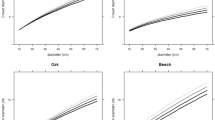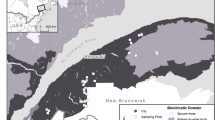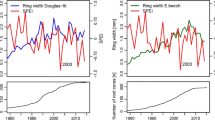Abstract
To analyze and quantitatively estimate the contribution of different factors of competition from the edificator tree stand to its effect on plants comprising the lower forest vegetation layer, a set of ecophysiologically based indices of root, light, and integrated competition has been proposed and tested. The results obtained in pine and spruce forests forests of Western Siberia and the Urals show that the growth of the conifer undergrowth is more closely correlated with the index of root competition, and that of heather (Calluna vulgaris (L.) Hull.), with the index of light competition from the edificator tree stand. Moreover, the correlation of their growth with the integrated competition index is 15–25% stronger than the correlation with the indices of root and light competition, irrespective of forest type.
Similar content being viewed by others
References
Abrazhko, V.I., Spatial Distribution and Biomass Dynamics of Spruce Roots, in Faktory regulyatsii ekosistem elovykh lesov (Regulatory Factors in Spruce Forest Ecosystems), Leningrad: Nauka, 1983, pp. 109–116.
Alekseev, V.A., Svetovoi rezhim lesa (The Light Regime of Forest), Leningrad: Nauka, 1975.
Begon, M., Harper, J.L., and Townsend, C.R., Ecology: Individuals, Populations and Communities, Oxford: Blackwell, 1986.
Clements, F.E., Plant Succession and Indicators, New York, 1928.
Daniels, R.F., Simple Competition Indices and Correlation with Annual Loblolly Pine Tree Growth, Forest Sci., 1976, vol. 22, no. 4, pp. 454–456.
Ek, A.R. and Monserud, R.A., Performance and Comparison of Stand Growth Models Based on Individual Tree and Diameter-Class Growth, Can. J. For. Res., 1979, no. 9, pp. 231–244.
Gorchakovskii, P.L., The Range of Heather: Geography, Ecology, and History of Formation, Bot. Zh., 1962, vol. 47, no. 9, pp. 1244–1257.
Harper, J.L., Population Biology of Plants, London: Academic Press, 1977.
Hegyi, F., A Simulation Model for Managing Jack-Pine Stands, in Growth Models for Tree and Stand Simulation, Stockholm: Royal College of Forestry, 1974, vol. 30, pp. 74–80.
Karev, G.P., A Mathematical Model of Competition for Light in Light-Limited Thinning Tree Stands, Zh. Obshch. Biol., 1985, vol. 46, no. 1, pp. 114–123.
Karev, G.P., On Mathematical Models of Plant Populations, in Ekologiya populyatsii (Population Ecology), Moscow: Nauka, 1991, pp. 229–238.
Karpov, V.G., Tree Root Competition and Structure of Herb-Dwarf Shrub Layer in Taiga Forests, Dokl. Akad. Nauk SSSR, 1958, no. 2, pp. 111–123.
Kasatkin, A.S., Usol’tsev, V.A., and Semyshev, M.M., Classification of Competition Indices in Tree Stands, in Lesnoe khozyaistvo i zelenoe stroitel’stvo v Zapadnoi Sibiri (Forestry and Afforestation in Western Siberia), Tomsk, 2009, pp. 108–113.
Kazantseva, A.S., Effect of Trees on the Structure of Herb-Dwarf Shrub Layer in Certain Types of Pine Forests, Bot. Zh., 1979, vol. 67, no. 7, pp. 1030–1033.
Kennel, R., Sociale Stellung, Nachbarshaft und Zuwachs, Forstwiss. Zbl., 1966, vol. 85, pp. 193–204.
Kimmins, J.P., Forest Ecology, New York: Macmillan, 1987.
Korzukhin, M.D. and Ter-Mikaelyan, M.G., Competition for Light and Dynamics of Model Individuals Independently Distributed over a Plane, Konkurentsiya za svet i dinamika model’nykh osobei, nezavisimo raspredelennykh na ploskosti, in Problemy ekologicheskogo monitoringa i modelirovanie ekosistem (Problems in Ecological Monitoring and Ecosystem Modeling), Leningrad: Gidrometeoizdat, 1982, vol. 5, pp. 242–248.
Kotov, S.F., A Method for Qualitative Assessment of the Edificator Role of Species, Bot. Zh., 1983, vol. 67, no. 2, pp. 235–240.
Kramer, P.D. and Kozlovskii, T.T., Fiziologiya drevesnykh rastenii (Physiology of Woody Plants), Moscow: Lesnaya Promyshlennost’, 1983.
Kurkin, K.A., Phytocenotic Competition: Systemic Dependence between the Partial Pressures of Competition for Different Resources, Bot. Zh., 1986, vol. 71, no. 6, pp. 723–732.
Laar, A., Konkurenzdruck und Zuwachs von Pinus radiata, Forstwiss. Zbl., 1973, vol. 92, no. 5, pp. 261–268.
Lakin, G.F., Biometriya (Biometry), Moscow: Vysshaya Shkola, 1980.
Lyr, H., Polster, H., and Fiedler, H.J., Gehölzphysiologie, Jena: Fischer, 1967.
Malkina, I.S., Tsel’niker, Yu.L., and Yanshina, A.M., Fotosintez i dykhanie podrosta (Photosynthesis and Respiration of Young Tree Growth), Moscow: Nauka, 1970.
Mindeeva, T.N., Factors of Variation in Radial Tree Increment in Even-Aged Pine Forests, Extended Abstract of Cand. Sci. (Agric.) Dissertation, Krasnoyarsk, 1995.
Odum, E., Basic Ecology, Philadelphia: Saunders, 1983. Translated under the title Ekologiya, Moscow: Mir, 1986.
Petrova, I.V., Sannikov, S.N., Sannikova, N.S., et al., Ecogeographic Features of Heather (Calluna vulgaris) Cenopopulations in the Russian Plain and Western Siberia, Izv. Orenburg. Gos. Agr. Univ., 2009, vol. 1(21), pp. 257–261.
Pianka, E.R. and MacArthur, R.H., On Optimal Use of a Patchy Environment, Am. Nat., 1966, vol. 100,no. 916, pp. 603–609.
Pielou, E.C., Mathematical Ecology, New York: Academic Press, 1977.
Pukkala, T., Methods to Describe the Competition Process in a Tree Stand, Scand. J. Forest. Res., 1989, vol. 4,no. 2, pp. 187–202.
Romanov, E.M., Vyrashchivanie seyantsev drevesnykh rastenii (Rearing of Tree Seedlings), Ioshkar-Ola: Mariisk. Gos. Univ., 2000.
Sannikov, S.N. and Sannikova, N.S., Ekologiya estestvennogo vozobnovleniya sosny pod pologom lesa (The Ecology of Natural Pine Regeneration under the Forest Canopy), Moscow: Nauka, 1985.
Sannikova, N.S., On the Quantitative Assessment of Root Competition from a Single Pine Tree, in Ekologicheskie issledovaniya v lesnykh i lugovykh biogeotsenozakh ravninnogo Zaural’ya (Ecological Studies in Forest and Meadow Biogeocenoses in the Transural Plains), Sverdlovsk: Ural.Nauch. Tsenr Akad. Nauk SSSR, 1979, pp. 21–26.
Sannikova, N.S., Mikroekosistemnyi analiz tsenopopulyatsii drevesnykh rastenii (Microecosystem Analysis of Woody Plant Cenopopulations), Yekaterinburg: Nauka, 1992.
Sannikova, N.S., Microecosystem Analysis of the Structure and Functions of Forest Biogeocenoses, Russ. J. Ecol., 2003, no. 2, pp. 80–85.
Sannikova, N.S. and Lokosova, E.I., Microecosystem Analysis of Structural and Functional Connections in Forest Biogeocenoses, in Geneticheskie i ekologicheskie issledovaniya v lesnykh ekosistemakh (Genetic and Ecological Studies in Forest Ecosystems), Yekaterinburg: Ural. Otd. Ross. Akad. Nauk, 2001, pp. 73–94.
Sannikova, N.S. and Petrova, I.V., Microecosystem Approach in Population Ecology and Biogeocenology, in Geneticheskaya tipologiya, dinamika i geografiya lesov Rossii (Genetic Typology, Dynamics, and Geography of Russian Forests), Yekaterinburg: Ural. Otd. Ross. Akad. Nauk, 2009, pp. 76–80.
Spurr, H.H., A Measure of Point Density, Forest Sci., 1962, vol. 8,no. 1, pp. 85–96.
Stern, K., Vollstandige Variancen und Kovariancen in Pflanzenbestanden, Silvae Genet., 1966, vol. 15,no. 1, pp. 6–11.
Sukachev, V.N., Basic Concepts of Forest Biogeocenology, in Osnovy lesnoi biogeotsenologii (Fundamentals of Forest Biogeocenology), Moscow: Nauka, 1964, pp. 5–49.
Tsel’niker, Yu.L., Radiatsionnyi rezhim pod pologom lesa (Radiation Regime under the Forest Canopy), Moscow: Nauka, 1969.
Usol’tsev, V.A., Fitomassa lesov Severnoi Evrazii: predel’naya produktivnost’ i geografiya (The Phytomass of Forest in Northern Eurasia: Ultimate Productivity and Geography), Yekaterinburg: Ural. Otd. Ross. Akad. Nauk, 2003.
Vasilevich, V.I., Interrelations of Plant Populations in Phytocenoses and Their Quantitative Evaluation, in Populyatsionnye problemy v biogeotsenologii (Population Problems in Biogeocenology), Moscow: Nauka, 1988, pp. 59–82.
Whittaker, R.H., Communities and Ecosystems, 2nd ed., New York: MacMillan, 1975.
Yastrebov, A.B. and Lychanaya, N.V., Studies on Phytogenic Fields of Trees in Lichen-Moss Pine Forests, Bot. Zh., 1993, vol. 78, no. 5, pp. 78–92.
Author information
Authors and Affiliations
Corresponding author
Additional information
Original Russian Text © N.S. Sannikova, S.N. Sannikov, I.V. Petrova, Yu.D. Mishchikhina, O.E. Cherepanova, 2012, published in Ekologiya, 2012, No. 6, pp. 403–409.
Rights and permissions
About this article
Cite this article
Sannikova, N.S., Sannikov, S.N., Petrova, I.V. et al. Competition factors of edificator tree stand: Quantitative analysis and synthesis. Russ J Ecol 43, 426–432 (2012). https://doi.org/10.1134/S1067413612060070
Received:
Published:
Issue Date:
DOI: https://doi.org/10.1134/S1067413612060070




